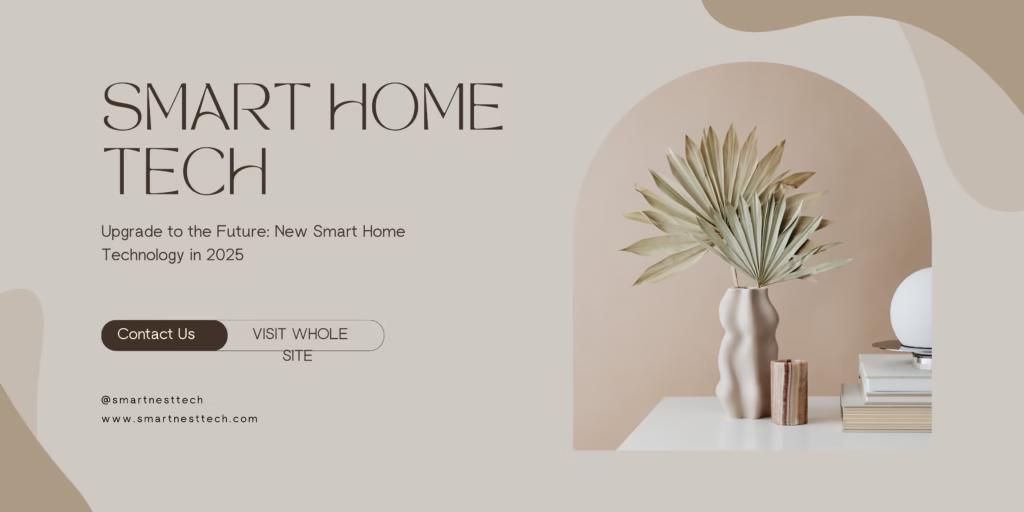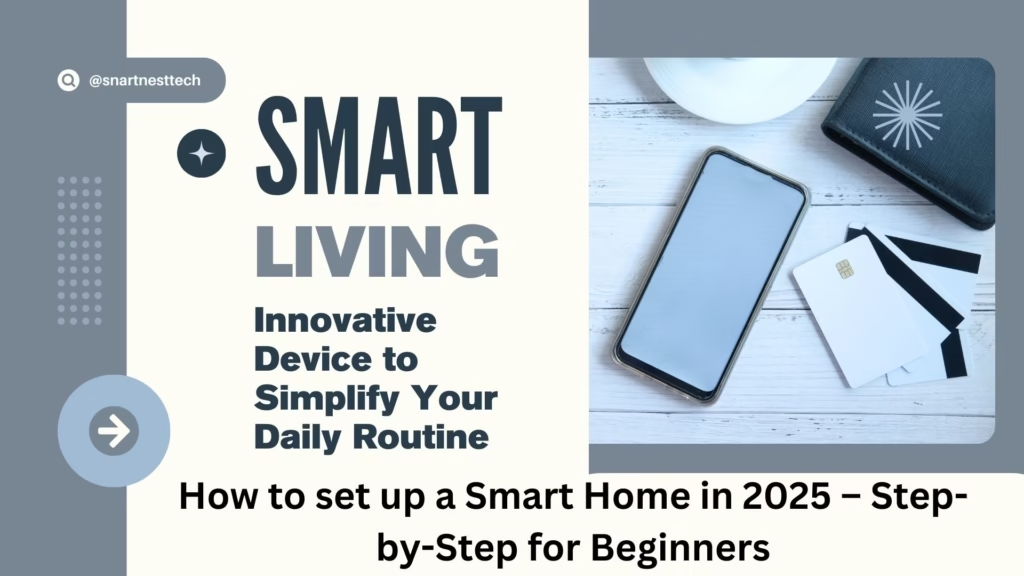In 2025, smart home technology is changing fast. The “Matter” standard is leading this change, aiming to make all smart home devices work together1. This standard was created by hundreds of brands, including Google, Amazon, and Apple. It promises to make controlling smart home devices easier and more efficient.
The smart home market is expected to hit $174 billion by 2025. This growth is thanks to new IoT and AI tech2. It shows that people want more smart home solutions.
Table of Contents

The “Matter” standard lets devices from different brands talk to each other easily. This makes managing smart homes simpler. It’s a big step towards a better smart home experience1.
As the smart home market expands, so does the demand for security. About 70% of homeowners want better security through smart devices2. This highlights the urgent need for new, innovative smart home tech.
Key Takeaways
The Evolution of Smart Home Innovation
- The “Matter” standard is set to revolutionize the smart home industry with its universal compatibility feature1.
- The smart home market is projected to reach $174 billion by 2025, driven by advancements in IoT and AI technologies2.
- Approximately 70% of homeowners express a desire for enhanced home security through smart devices2.
- Smart home devices are expected to grow in adoption, with estimates suggesting that over 50% of households will have at least one smart device by 20252.
- The integration of smart home technology can lead to a 20% increase in overall home efficiency2.
- Amazon Alexa Plus is priced at $19.99 per month and included in Prime membership3.
Smart home innovation has changed how we live and interact with our homes. AI-driven systems are making homes smarter and more automated. The global smart home market is set to hit about $174 billion by 2025, growing at a 25% annual rate from 20204.
More people want smart home devices, with 70% of U.S. households having at least one in 20224. AI systems are expected to cut costs by up to 30% for businesses that use them4.
There’s a big trend in voice assistants, like Amazon’s Alexa+, which will cost nearly $20 a month for non-Prime members5. Alexa+ will start in the U.S. in March 2025, supporting only English at first5. As smart home tech keeps improving, we’ll see more AI-driven gadgets that make our lives simpler.
Revolutionary New Technology for Smart Homes in 2025
New technology is changing how we live, making smart home devices key6. Samsung is at the forefront, aiming to make Generative AI part of our daily lives by 20256. This move towards AI-powered homes promises a smoother experience in entertainment and personal help.
These new smart home devices offer energy efficiency, enhanced security, and convenience. For instance, smart security cameras give real-time updates, helping homeowners act fast. The SmartThings platform will grow from simple tasks to predicting what we need6.
The smart home industry is growing, bringing new, exciting solutions. It’s an exciting time for homeowners wanting to update their homes with the latest tech6.
AI-Powered Home Management Systems
AI-powered home management is changing how we live and interact with our homes. These systems use advanced learning algorithms to learn our habits and preferences. For example, a smart home can adjust lighting, temperature, and entertainment based on our daily routines7.
AI systems can also predict and prevent problems. They can detect issues before they happen, reducing the chance of equipment failure and downtime7. Plus, they can be customized to fit our individual needs, making our homes more comfortable.
Some key features of AI-powered home management systems include:
- Advanced learning algorithms for personalized automation
- Predictive maintenance features for reduced downtime
- Integration with various smart devices for seamless control
Studies show that AI systems can respond 25% faster than traditional solutions7. They can also work with wearable and environmental sensors to collect data continuously. This allows for real-time monitoring and analysis7.
It’s important to keep AI-powered home systems safe from cyber threats. With smart devices facing 10 cyber attacks every 24 hours8, strong security is key. This includes using strong passwords, two-factor authentication, and keeping software up to date8.
Breakthrough Energy Management Solutions
Energy management solutions are key in smart homes. They help homeowners cut down on energy use and lower bills. Smart home energy systems can automatically adjust, making energy use better9. They work with other smart devices, like thermostats and lights, for a full energy management plan.
Benefits of these solutions include:
- Less energy use
- Lower bills
- A smaller carbon footprint
Smart home energy systems can be controlled from anywhere. They give real-time energy use data10.
Other solutions like energy-efficient appliances and renewable energy sources also help. They cut down energy use and bills, and reduce carbon footprint11.

Energy management solutions are vital for smart homes. They help homeowners use less energy and save on bills. By using smart systems and other efficient solutions, homes become more sustainable and energy-smart.
Next-Generation Security Features
Technology keeps getting better, and so does our need for strong security. New security features are being made to protect us and our data better. One big step is biometric integration, which makes logging in safer and easier12.
Biometric integration uses things like fingerprints or facial scans to check who you are. It’s showing up in phones and smart homes. For example, Samsung’s Galaxy S25 series has cool cameras and fast performance12.
AI-powered surveillance is another big step in security. These systems use smart tech to watch videos and spot dangers. They have high-quality cameras and wide views13.
These new security tools offer many benefits. They make our data safer, easier to use, and harder to hack13.
- Enhanced security and protection against data breaches
- Increased convenience and ease of use
- Reduced risk of unauthorized access
Next-generation security, like biometrics and AI surveillance, is changing how we protect ourselves. It’s making our lives safer and more convenient13.
Smart Kitchen and Appliance Innovation
The smart kitchen is now a center for appliance innovation. Many homes have smart refrigerators, ovens, and dishwashers14. These gadgets make life easier, use less energy, and improve cooking.
For instance, smart fridges can order groceries when they’re low. This makes planning meals and shopping easier.
Smart kitchen appliances offer remote monitoring and control. Homeowners can adjust settings and get updates from their appliances15. This is great for busy families, helping them manage their cooking and cleaning.
They also work well with other smart home systems. This creates a connected and seamless living space.
Key features of smart kitchen appliances include:
- Energy efficiency
- Remote monitoring and control
- Automated maintenance and troubleshooting
These features make cooking and cleaning simpler. They also help make our lives more sustainable and energy-efficient14.
As more people want smart kitchen appliances, makers are working hard to improve them15. With smart kitchen tech getting better, our homes will soon be even more convenient and automated.
Health and Wellness Monitoring Systems
Health and wellness monitoring systems are key in today’s world. They help us track our vital signs and get tips for better health16. About 70% of people will use these devices by 202516.
These systems offer many benefits. They improve our health, make life easier, and boost our well-being. For example, wearable devices track our heart rate and oxygen levels. This helps insurers create better health plans for us17. The use of these systems is expected to grow fast, with a 25% CAGR from 2023 to 202816.
These systems have cool features like tracking our health, improving sleep, and controlling our environment. They help us focus on our health from all angles. With the global market set to hit $30 billion by 202516, these systems are becoming a big part of our lives.
In short, health and wellness monitoring systems are vital in today’s healthcare. They offer many benefits and features that improve our well-being. As more people want these systems, it’s clear how important health and wellness and environmental quality control are in our lives18.
Entertainment and Media Control Centers
Media control centers are key for a better entertainment experience. They let you control many devices easily, making things more convenient and flexible19. For example, smart TVs give you access to lots of streaming services. This means you can watch your favorite shows and movies with ease.
These centers also include smart speakers and gaming consoles. You can control them all with one interface. This makes switching between entertainment types simple. Recently, smart speaker use has gone up a lot. People use them a lot for music and voice commands20.
Media control centers have some important features. They offer: * Easy device control * Access to many streaming services * Voice control * Connection with smart home systems These features make entertainment better, giving users a fun and easy way to enjoy their favorite content21.

Integration and Compatibility Standards
The smart home industry is growing fast. It’s vital for devices to work well together. The Connectivity Standards Alliance says Matter makes it easier for companies to support devices, but it should have started sooner22.
Universal device protocols and cross-platform functionality are key. They let devices from different makers work together smoothly. For example, Zigbee or Z-Wave protocols help devices integrate well, making a smart home system work as one23.
It’s also important to support older devices. New tech should work with old devices, making smart homes more flexible and useful. By focusing on integration and compatibility, makers can make smart homes better for everyone.
In short, integration and compatibility are essential for smart homes. Makers should focus on universal protocols, cross-platform use, and supporting old devices. This way, smart homes will be more efficient and enjoyable for users22.
Cost Considerations and Implementation Strategies
When thinking about smart homes, cost considerations are key. The price of smart devices varies a lot. It depends on the device type, brand, and installation complexity24. But, smart homes can save a lot on energy and make life easier. For instance, smart grids use energy wisely, cutting down on waste24.
Choosing the right devices for your home and budget is important. Getting help from a pro installer ensures devices work right24. Also, smart homes can save money and increase your home’s value over time. Think about the upfront cost, ongoing expenses, and energy savings when deciding25.
Devices like smart thermostats, lights, and security systems can cut energy use. They can be controlled from anywhere and adjust to your habits24. By picking the right devices, you can save money and help the planet.
The cost of smart home devices varies a lot. It can be from a few hundred to thousands of dollars25. But, with smart homes, you can save a lot on energy and enjoy more convenience. It’s a smart investment for the future.
Conclusion: Embracing the Smart Home Revolution
The smart home revolution is changing how we live in amazing ways. It brings advanced AI, better energy use, and top-notch security. The future of smart homes is exciting and here now26.
Everyone can enjoy more convenience, comfort, and save money with these new techs26. Devices will work together smoothly, making it easy to keep up with new smart home trends.
While it might cost more upfront, smart homes save money and energy in the long run26. Governments are helping make these systems more affordable. This makes smart homes the new norm in homes.
Smart home tech brings us a future with more ease, energy savings, and safety. The future is bright, and it’s time to join the smart home movement.
FAQ's
What is the “Matter” standard and how does it help smart home devices communicate with each other?
The “Matter” standard is a big deal in the smart home world. It’s a project of hundreds of brands, like Google, Amazon, and Apple. It lets devices from different makers talk to each other easily. This makes it simpler for homeowners to manage their smart homes.
What are the current market trends and predictions for the smart home industry?
The smart home world is changing fast. We’re moving from simple automation to systems powered by AI. The market is growing, and people want more AI in their homes. Samsung’s new Galaxy S25 series is a big step forward, with cool AI and camera tech.
What are some of the revolutionary new technologies for smart homes in 2025?
New tech for smart homes includes smart cameras, thermostats, and locks. These devices save energy, make homes safer, and are super convenient. For example, smart cameras give live updates, so you can act fast if needed.
How do AI-powered home management systems benefit homeowners?
AI systems for homes learn and adapt, helping with maintenance and automation. They make homes more efficient, save energy, and keep homes safe. The Connectivity Standards Alliance says Matter is helping companies support these systems better, but it should have started sooner.
What are the benefits of breakthrough energy management solutions for smart homes?
New energy solutions for homes cut down on energy use and bills. They also help the planet. For instance, smart thermostats can turn on and off automatically, saving energy.
What are the advancements in next-generation security features for smart homes?
New security features include better biometrics, AI surveillance, and quantum encryption. These make homes safer, more convenient, and less vulnerable to hacking. Samsung’s Galaxy S25 series shows off advanced camera and performance tech.
What are the innovations in smart kitchen and appliance technology?
Smart kitchens now have smart fridges, ovens, and dishwashers. These innovations save energy, make cooking easier, and are super convenient. For example, smart fridges can order groceries when they’re low.
How do health and wellness monitoring systems benefit smart home residents?
Health monitoring systems track air quality, personal health, and sleep. They improve health, make life easier, and boost well-being. Samsung’s Galaxy S25 series offers daily health insights, giving a full health picture.
What are the advancements in entertainment and media control centers for smart homes?
Smart homes now have better TVs, speakers, and gaming consoles. These offer more convenience, better entertainment, and easy control. For example, smart TVs give access to lots of streaming services, so you can watch your favorite shows.
What are the benefits of integration and compatibility standards for smart home devices?
Standards like Matter make devices work together better. They make homes more convenient, simpler to manage, and more compatible. Matter has helped companies support these systems, but it should have started sooner.
What are the cost considerations and implementation strategies for smart home technology?
Getting smart home tech involves thinking about costs and how to set it up. Planning and budgeting are key to saving money and enjoying your smart home. Professional installation ensures devices work right and last longer.
Source Links
- 5 Ways the Smart Home Standard Matter Needs to Change in 2025
- Smart Home
- With Alexa Plus, Amazon finally reinvents its best product
- The Rapid Evolution of Technology: Transforming the Digital Landscape
- Amazon Unveils Alexa+: The AI Assistant Revolutionizing Home Tech
- 2025: Samsung’s AI revolution – a glimpse Into the future of smart living
- Integrating generative adversarial networks with IoT for adaptive AI-powered personalized elderly care in smart homes. – Yesil Science
- 8 ways to secure your smart home from hackers
- Energy Technology News
- Energy and the Environment News
- Scientists create mind-blowing phenomenon inside first-of-its-kind energy device: ‘We were all very excited’
- Everything you need to know about Alexa+, Amazon’s new generative AI assistant
- Lorex 4K Spotlight Indoor/Outdoor Wi-Fi 6 Security Camera with Smart Security Lighting (32GB, Cloud-Enabled)
- Smart Dryers: What Advances Are Coming in 2025?
- Discover the Best Voice Assistant Apps for Your Smart Home in 2025
- The New Technology of Intelligent Health Physical Fitness Detection Based on Mobile Terminal
- How digital health innovations are shaping the future of medical policy | London Daily News
- Smart wireless flexible sensing system for unconstrained monitoring of ballistocardiogram and respiration – npj Flexible Electronics
- Samsung Solidifies its Mobile AI Leadership at MWC 2025: From Galaxy AI to Software-Centric Networks
- Indian Media Conglomerate – Smart-i Electronics
- TechRadar | the technology experts
- The Opportunities and Challenges of Digital Technologies in Energy Systems to Reduce GHG Emissions
- Tunnel BIM Model Integration Construction Method and Engineering Application – Iranian Journal of Science and Technology, Transactions of Civil Engineering
- Shaping Cities of Tomorrow: Key Technologies Leading the Way
- Light Bulb Market Size & Growth [2033]
- Best 7 Game-Changing Hybrid Solar Power: Harness the Energy
Related
Discover more from
Subscribe to get the latest posts sent to your email.



